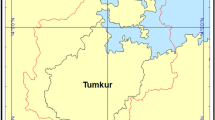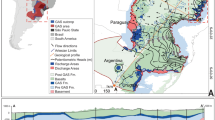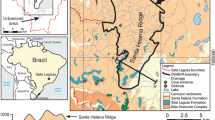Abstract
Understanding the spatial variability of groundwater recharge in response to distributed Land-use, soil texture, topography, groundwater level, and hydrometeorological parameters is significant when considering the security of groundwater resource development. Thus, this study was aimed at estimating the spatial groundwater recharge of Raya valley, northern Ethiopia using spatially distributed water balance model (WetSpass). Input data for the model were prepared in the form of grid maps using 90 m grid size and the parameter attribute tables were adjusted to represent the Raya valley condition using expert knowledge and scientific literatures. The results of the model indicated that the long-term temporal and spatial average annual rainfall of 710 mm was partitioned as 57 mm (8%) of surface runoff, 598 mm (84%) of evapotranspiration, and 55 mm (8%) of recharge. The recharge corresponds to 137 million cubic meters (Mm3) for the Raya basin (with area of about 2500 km2) from which 84% of the recharge takes place during summer season, while the remaining 16% takes place during the winter (dry) season. The analysis of the simulated result showed that WetSpass works well to simulate water balance components of Raya valley and is especially suitable for studying the effects of Land-use changes on the water regime in the basin.








Similar content being viewed by others
References
Aish AM, Batelaan O, De Smedt F (2010) Distributed recharge estimation for groundwater modeling using wetspass. Arab J Sci Eng 35(1):155–163
Al Kuisi M, El-Naqa A (2013) GIS based spatial groundwater recharge estimation in the jafr basin, jordan—application of wetspass models for arid regions. Rev Mex Cienc Geol 30(1):96–109
Allen RG, Pereira LS, Raes D, Smith M (1998) Crop evapotranspiration: guidelines for computing crop water requirements. FAO irrigation and drainage paper no. 56. FAO, Rome
Arefaine T, Nedaw D, Gebreyohannes T (2012) Groundwater recharge, evapotranspiration and surface runoff estimation using WetSpass modeling method in Illala Catchment, Northern Ethiopia. Momona Ethiop J Sci 4(2):96–110
Arkoprovo B, Adarsa J, Prakash SS (2012) Delineation of groundwater potential zones using satellite remote sensing and geographic information system techniques: a case study from Ganjam district, Orissa, India. Res J Recent Sci 1(9):59–66
Arkoprovo B, Adarsa J, Animesh M (2013) Application of remote sensing, GIS and MIF technique for elucidation of groundwater potential zones from a part of Orissa coastal tract, Eastern India. Res J Recent Sci 2(11):42–49
Armanuos AM, Negm A, Yoshimura C, Saavedra Valeriano OC (2016) Application of WetSpass model to estimate groundwater recharge variability in the Nile Delta aquifer. Arab J Geosci. https://doi.org/10.1007/s12517-016-2580-x
Ayenew T, Demlie M, Wohnlich S (2008) Hydrogeological framework and occurrence of groundwater in the Ethiopian aquifers. J Afr Earth Sci 52(3):97–113
Ayenew T, GebreEgiabher M, Kebede S, Mamo S (2013) Integrated assessment of hydrogeology and water quality for groundwater-based irrigation development in the Raya Valley, northern Ethiopia. Water Int 38(4):480–492
Batelaan O, De Smedt F (2001) WetSpass: aflexible, GIS based,distributed recharge methodology for regional groundwater modelling. In: Gehrels H, Peters J, Hoehn E, Jensen K, Leibundgut C, Griffioen J, Webb B, Zaadnoordijk W-J (eds) Impact of human activity on groundwater dynamics, Publ. no. 269. IAHS, Wallingford, pp 11–17
Batelaan O, De Smedt F (2007) GIS-based recharge estimation by coupling surface - subsurface water balances. J Hydrol 337:337–355. https://doi.org/10.1016/j.jhydrol.2007.02.001
Belete K(2007) Sedimentation and sediment handling at dams in Tekeze River Basin, Ethiopia. PhD thesis, Norwegian University of Science and Technology, Faculty of Engineering Science and Technology, Department of hydraulic and Environmental Engineering, Trondheim, Norway
Chow VT, Maidment DR, Mays LW (1988) Applied Hydrology. McGraw-Hill, New York
Cook PG, Walker GR, Buselli G, Potts I, Dodd AR (1992) The application of electromagnetic techniques to groundwater recharge investigations. J Hydrol 130:201–229
De Vries JJ, Simmers I (2002) Groundwater recharge: an overview of processes and challenges. Hydrogeology J 10(1):5–17. https://doi.org/10.1007/s10040-001-0171-7
FAO (1998) Land and water digital media series -the soil and terrain database for northeastern Africa. FAO, Land and Water Digital Media Series no, 2. FAO, Rome
Fenta AA, Kifle A, Gebreyohannes T, Hailu G (2014) Spatial analysis of groundwater potential using remote sensing and GIS-based multi-criteria evaluation in Raya Valley, northern Ethiopia. Hydrogeol J 23(1):195–206. https://doi.org/10.1007/s10040-014-1198-x
Foody GM (2002) Status of land cover classification accuracy assessment. Remote Sens Environ 80:185–201
Gebreyohannes T, Smedt FD, Walraevens K, Gebresilassie S, Hussien A, Hagos M, Gebrehiwot K (2013) Application of a spatially distributed water balance model for assessing surface water and groundwater resources in The Geba Basin, Tigray, Ethiopia. J Hydrol 499:110–123. https://doi.org/10.1016/j.jhydrol.2013.06.026
German Agency for Technical Cooperation LTD (1977) Kobo-Alamata Agricultural Development Program, Volume II: Annexes Pedology and Water Development. ESSEN, GERMANY: German consults, http://eusoils.jrc.ec.europa.eu/esdb_archive/eudasm/africa/lists/k5_cet.htm. Accessed 28 Nov 2014
Lillesand MT, Kiefer WR (2000) Remote sensing and image analysis, 4th edn. Wiley, New York
MoA (1998) Agro-ecological zones of Ethiopia, ministry of agriculture. Natural Resources Management and Regulatory Department, Addis Ababa
Nadew D (2003) Aquifer characterization and hydro-chemical investigation in the Raya Valley, northern Ethiopia. PHD Thesis, University Life Sciences (Boku), Vienna, 204 pp
Pandian M, Rajasimman U, Saravanavel J (2014) Original article identification of groundwater potential recharge zones using WETSPASS model in parts of Coimbatore and Tiruppur Districts in Tamil Nadu, India. Int J Water Res 2(1):27–32
Pilgrim DH, Cordery I (1992) Flood runoff. In: Maidment DR (ed) Handbook of hydrology. McGraw-Hill, New York, pp. 9.1–9.41
Rubin J (1966) Theory of rainfall uptake by soils initially drier than their field capacity and its applications. Water Resour Res 2(4):739–749
Rwanga SS (2013) A review on groundwater recharge estimation using Wetspass Model. In: International conference on civil and environmental engineering 156–160
Scanlon B, Healy R, Cook P (2002) Choosing appropriate techniques for quantifying groundwater recharge. Hydrogeol J 10(1):18–39
Simmers I, Hendrickx JMH, Kruseman GP, Rushton KR (1997) Recharge of phreatic aquifers in semi-arid areas. International contributions to hydrogeology: IAH international association of hydrogeologists. Balkema, Rotterdam
Smedema LK, Rycroft DW (1988) Land Drainage. Batsford, London
Su X, Singh VP, Niu J, Hao L (2015) Spatio temporal trends of aridity index in Shiyang River basin of northwest China. Stoch Environ Res Risk Assess 29:1571–1582
Tadesse N, Nedaw D, Woldearegay K, Gebreyohannes T, Steenbergen FV (2015) Groundwater management for irrigation in the raya and kobo valleys, Northern Ethiopia. Int J Earth Sci Eng 8(3):1104–1114
Tesfaye S, Harding DJ, Kusky TM (2003) Early continental breakup boundary and migration of the Afar triple junction, Ethiopia. Bull Geol Soc Am 115(9):1053–1067. https://doi.org/10.1130/B25149.1
Tilahun K, Merkel BJ (2009) Estimation of groundwater recharge using a GIS-based distributed water balance model in Dire Dawa, Ethiopia. Hydrogeol J 17:1443–1457. https://doi.org/10.1007/s10040-009-0455-x
Todd DK, Mays LW (2005) Groundwater hydrology. 3ed. Wiley, Hoboken
Acknowledgements
The authors would like to thank Mekelle University, Technical University of Darmstadt and World Agroforestry Centre (ICRAF) for providing the necessary support and funding to conduct the study. We are grateful to the three anonymous referees for constructive comments on an earlier version of this manuscript.
Author information
Authors and Affiliations
Corresponding author
Rights and permissions
About this article
Cite this article
Kahsay, G.H., Gebreyohannes, T., Gebremedhin, M.A. et al. Spatial groundwater recharge estimation in Raya basin, Northern Ethiopia: an approach using GIS based water balance model. Sustain. Water Resour. Manag. 5, 961–975 (2019). https://doi.org/10.1007/s40899-018-0272-2
Received:
Accepted:
Published:
Issue Date:
DOI: https://doi.org/10.1007/s40899-018-0272-2




